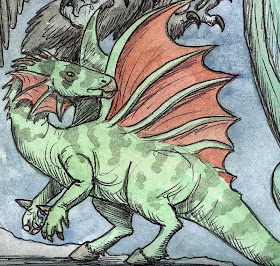Apatosaurus was a plant-eating dinosaur that lived in what is now Western North America, during the late Jurassic Period, about 152 million years ago. It was a massive dinosaur, measuring on average about seventy five feet long from snout to tail, but there is evidence showing that some adults grew even larger than that. Apatosaurus could have potentially grown to have been one of the largest animals to ever walk on land! The genus name, Apatosaurus, translates to "deceptive reptile", because its bones were confusingly similar to those of other sauropods', mainly Brontosaurus.
Like its relatives, the other diplodocids, Apatosaurus would have had peg-like teeth in the front of its mouth for stripping foliage off of trees. It then would have swallowed all of its food whole to let its digestive system do most of the work, rather than chew, since it had no teeth in the back of its mouth to do so with. Sauropods, like Apatosaurus, also show evidence of having swallowed small rocks (by small I mean fist-sized considering how freaking huge these animals were) called gastroliths. These rocks would aid in breaking down swallowed food inside the body by being tossed around with the plant material. Many birds will engage in this same behavior today since they don't have any teeth for chewing, either.
 |
| Apatosaurus louisae skeletal mount on display at the Carnegie Museum of Natural History. |
You might be wondering how an animal so large and heavily built as Apatosaurus would have ever been able to support itself on land. The secret lies in the bones themselves of Apatosaurus, and many other large dinosaurs. You see, like modern birds, the bones of Apatosaurus had a series of air chambers in them, making them hollow. Many birds today use this adaptation to make themselves light enough to fly, but other dinosaurs, like Apatosaurus for instance, took this adaptation in a completely different direction, to allow themselves to evolve utterly huge bodies without crushing themselves under their own weight. In some ways, sauropod bones were a lot like cinder blocks, which can cover more space to more easily build a large structure but have holes (in the right places engineering-wise) to remain as light as possible. These air sacs may have also helped Apatosaurus' respiration system, better spreading oxygen throughout its huge body, which birds do with their hollow bones today, as well.
That is all for this week! As always feel free to comment below or on our facebook page!
References
Tschopp, E.; Mateus, O. V.; Benson, R. B. J. (2015). "A specimen-level phylogenetic analysis and taxonomic revision of Diplodocidae (Dinosauria, Sauropoda)". PeerJ 3: e857.
Upchurch, P. (1994). "Manus claw function in sauropod dinosaurs" (PDF). Gaia 10: 161–171. ISSN 0871-5424.
Wedel, M. J. (2003). "Vertebral Pneumaticity, Air Sacs, and the Physiology of Sauropod Dinosaurs". Paleobiology 29 (2): 243–255. doi:10.1666/0094-8373(2003)029<0243:vpasat>2.0.co;2. JSTOR 4096832.
Wedel, M. (2013). "A giant, skeletally immature individual of Apatosaurus from the Morrison Formation of Oklahoma" (PDF). 61st Symposium on Vertebrate Palaeontology and Comparative Anatomy Programme and Abstracts: 40–45.

.jpg)



.JPG)

























